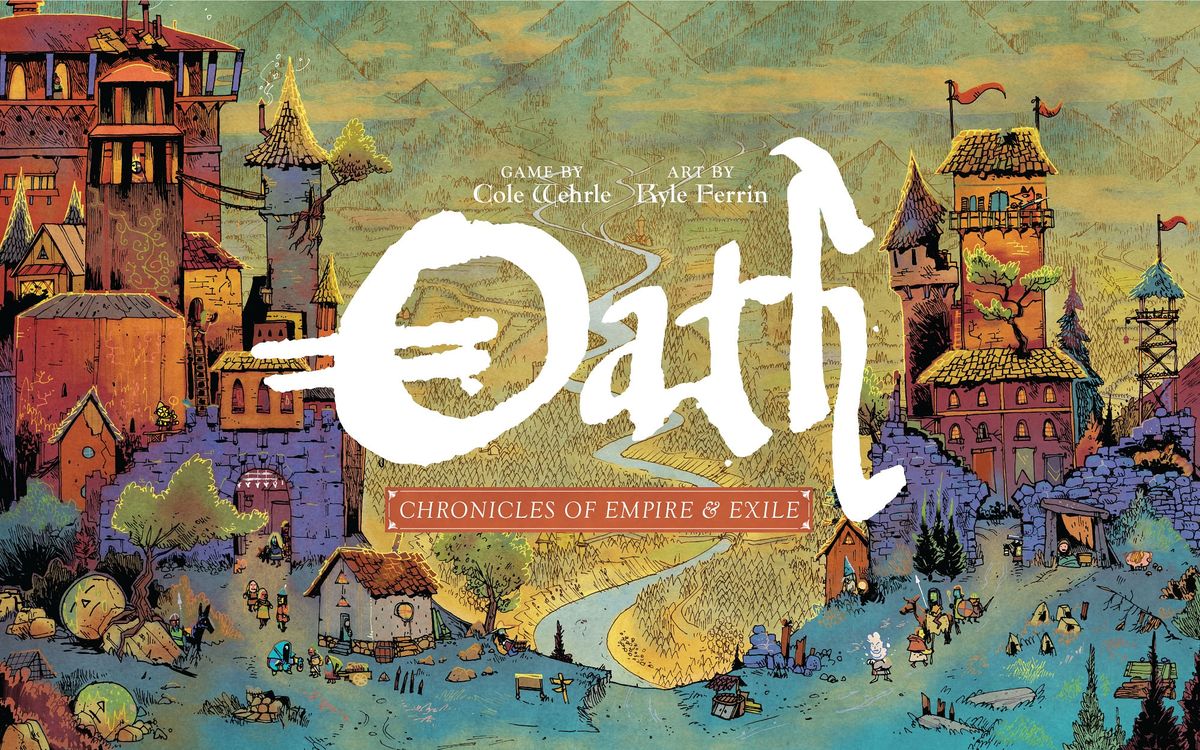Kickstart This! #163: Oath: Chronicles of Empire and Exile

Designer: Cole Wehrle (Pax Pamir, Pax Pamir 2nd Edition, Root)
Artist: Kyle Ferrin (Dungeon Mayhem, Root, Vast: The Crystal Caverns)
Publisher: Leder Games (Root, Vast: The Crystal Caverns, Vast: The Mysterious Manor)
Genre/Mechanisms: area majority/influence, area movement, card drafting, political
Funding Status: At the time of this posting, Oath: Chronicles of Empire and Exile is already fully-funded. In fact, pledges currently total more than 17x the initial funding goal, with 7 days left to go on the campaign!
Player Count: 1-6
Solo Mode: yes
Complexity: medium-heavy
Risk: medium-low
What It’s About: “In Oath, one to six players guide the course of history in an ancient land. Players might take the role of agents bolstering the old order or scheme to bring the kingdom to ruin. The consequences of one game will ripple through those that follow, changing what resources and actions future players may have at their disposal and even altering the game’s core victory condition.”
How It Works: Oath is played over a series of rounds. The number of rounds is determined by a die roll at the ends of the 5th, 6th, and 7th rounds. There’s a 16% chance the game ends after 5 rounds, a 28% chance it ends after 6 rounds, a 37% chance it ends after 7 rounds, and a 19% chance it ends after 8 rounds.
Each round, players take their turns in clockwise order, starting with the Chancellor role assigned at the beginning of the game. Each player resolves three phases on their turn, in the following order.
Influence: gaining favor or magic, which are resources that can be used for various abilities throughout play.
Actions: taking 3 actions (2 if the player is also the Chancellor), in addition to any number of minor actions. Actions include Travel (move your pawn to a different site), Muster (gain warbands by spending favor), Play (draw cards and playing one to your site of cohort), Campaign (attack sites paw, and privileges), and Rest (refresh your effort and manage your cohort).
Cleanup: returning favor on cards to their appropriate supplies, and returning magic on cards to themselves. During the Cleanup Phase, a player scores Victory Points shown by the current round if the current board state has them fulfilling the game’s Oath condition. Possible Oaths include Supremacy (rule the most sites), Devotion (hold the Dark Secret privilege), Protection (hold the Blessing privilege), and the People (have the most Popular Support).
Additionally, the normal game length (and the number of rounds an average game could be) are interrupted by game-ending conditions called Visions. These are almost identical to the conditions behind the Oaths, but at least three Visions have to have been seen during the game, and your vision must be face-up and fulfilled at the start of your turn. Which means, players have a full turn each to try to foil or interrupt your win condition. Think of this as a mechanic similar to winning by Dominance Cards in Root.
If no player wins by Vision, then the player with the most Victory Points when the game ends (at the end of rounds 5-8, depending on dice rolls) is declared winner.
After the game is complete, player perform The Chronicle Phase. 1) If a player won the game with a Vision, the corresponding Oath becomes the winning Oath condition for the next game. Otherwise, the victor chooses the next game’s Oath. 2) The game’s map is adjusted, removing site cards not garrisoned by the winner, and replacing a garrison at the victor’s pawn site with a war band if the winner has no garrisons on the map. 3) Six cards are added to the deck, their suits depending on the finished game’s victory conditions. 4) Suit supply markers are shifted. 5) Six cards from the discard pile are removed from the game. 6) The deck is rebuilt. 7) The game’s map is “saved” for future play.
Comparisons: Looking to Cole Wehrle’s two previous designs likely provides the target in the middle where Oath lies. Those 2 games are Root, another asymmetrical dudes-on-a-map game featuring cute forest animals, and Pax Pamir, featuring heavier political interest and leanings, implemented in Oath by the game’s Chronicle Phase. The Vast series, also by Leder Games, is another good example of this style of asymmetrical player powers.
Of course, none of those games includes what makes Oath truly unique– the way the results of each game of Oath informs and affects the next. Not in the sense of a legacy game, because nothing here is destroyed or altered, and not even in the sense of a campaign game, because the individual games can be played by different players with no knowledge of what came before. But more in a thematic sense. If some or all players are the same from one game to the next, they’ll have the additional experience of seeing how the previous game affected the landscape of its successor– how it altered the layout of the board around the previous victor’s territory, how it changed victory conditions for the next game, and how it affected new cards that may be introduced. Players witness the growth and change of an empire over a longer period of time, and have some agency in this larger, world-shaping journey.
What Should I Pledge?:
$90 Oath Pledge: includes the base game, the Deluxe Component Set, and the Chronicle Session Journal.
Add-Ons:
$30 Custom Oath Bridge Card Sleeves
KS Exclusives:
None.
All-In Total: In the continental U.S., you’re looking at $90 for the Oath pledge, $30 for the Custom Oath Bridge Card Sleeves, and $16 in estimated shipping for a total of $136.
Oath: Chronicles of Empire and Exile completes its Kickstarter on Tuesday, February 4th and tentatively ships in January 2021.